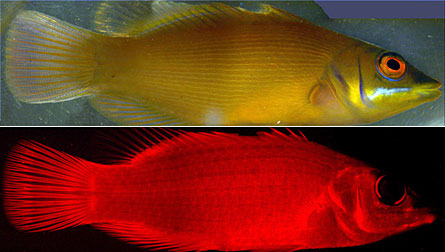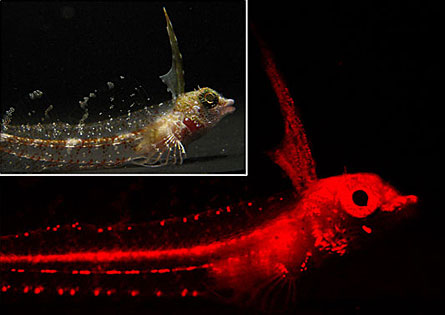A lot of reef creatures could be in the red.


A widespread capacity for fish, corals, worms and other animals to fluoresce red has been largely overlooked, contend Nico Michiels of the University of Tübingen in Germany and colleagues in a new study.
Seawater quickly absorbs the red wavelengths of daylight filtering through, so that at depths below 10 meters the red portion of sunlight disappears and the blues and greens dominate. The majority of fish tested so far from this zone have vision tuned to blues and greens.
Reef biologists have treated red as “irrelevant,” Michiels says. Red, however, deserves more attention since a substantial number of reef animals produce their own red glow, he and colleagues say in an upcoming BMC Ecology.
Michiels noticed the red fluorescence in 2007 while diving with a mask that filtered out all but red wavelengths for another project. As he descended, the sun’s available red light dwindled quickly, leaving him in virtual darkness. Then he was startled to see the red fluorescent eyes of a fish, the red fin of another …. Since then, he and collaborators have found that 32 reef fishes sampled from 16 genera give off a red fluorescent glow. Substances on their bodies capture light at other wavelengths and release the energy as red light.
Species of pipefish, triplefins, blennies and gobies had fluorescent red patches, as did species of other common reef-dwellers, such as corals, a polychaete worm, feather stars and several sponges.
One goby the researchers studied, Eviota pellucida, has eye structures that appear able to detect fluorescence in its own species, Michiels says. Earlier studies of pipefish show they can pick up red too. However, many of the other reef species’ visual capacities have never been tested in detail, he says.
Most of the red-fluorescing fish are small and likely to have mates or neighbors close by, so red glows would make good short-range signals for courtship or other local business, Michiels suggests. The idea that seawater has rendered red ineffective “is a kind of dogma we are attacking,” he says. “I would hope that the whole light ecology of reefs is reconsidered.”
He’s got a way to go in making his case, says Justin Marshall of the University of Queensland in Brisbane, Australia. A reef ecologist who studies vision, Marshall says he has been aware of reef fish that fluoresce red, but the effects are weak. He still expects that fish would have to struggle, even if they were able to see the color at all. He would need to see evidence from behavior experiments to be convinced that red glow is useful, he says.
Testing behavior “is the next big thing” on the agenda, Michiels says.






